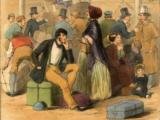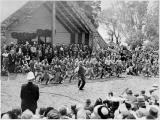The originator of the New Zealand Company was elected to the House of Representatives as the member for Hutt six months after arriving in the colony. He had been quick to lobby for the introduction of responsible government.
New Zealand Company
Events In History
The Fifeshire arrived in Nelson with immigrants for the New Zealand Company's first settlement in the South Island.
The New Zealand Company's first settler ship, the Aurora, arrived at Petone to found the settlement that would become Wellington.
The sailing ship Tory dropped anchor in Queen Charlotte Sound to pick up fresh water, food and wood before proceeding to Port Nicholson (Wellington Harbour).
Articles
British & Irish immigration, 1840-1914

Who were the ancestors of Pākehā New Zealand? Where did they come from and what sort of people were they? These are some of the questions which this feature sets out to answer. Read the full article
Page 2 - Overview - immigration to New Zealand 1840-1914
Overview of immigration trends
Page 3 - Where did they come from?
The composition of the inflow from Britain and Ireland was quite different from the composition of the United Kingdom as a whole.
Page 4 - English immigrants
Table and graph showing which part of England immigrants to New Zealand came
Page 5 - Scottish immigrants
Table and graph showing which part of Scotland immigrants to New Zealand came
Page 9 - Conclusions about immigration 1840-1914
These statistics suggest some larger conclusions about the character and values of New Zealand's founding Pākehā
Taming the frontier

In 1832 James Busby was appointed as the official British Resident to New Zealand. After arriving in the Bay of Islands in May 1833 he took steps to tame what he saw as a chaotic frontier society. Read the full article
Page 4 - Land issues on the eve of the Treaty of Waitangi
In the late 1830s the British government became concerned about how land was being obtained from Māori. Action was needed, it decided, to protect Māori from the worst ravages of
Treaty timeline

See some of the key events between 1800 and 1849 relating to the Treaty of Waitangi. Read the full article
Page 1 - Treaty events 1800-49
See some of the key events between 1800 and 1849 relating to the Treaty of Waitangi.
Exploring New Zealand's interior

After charting the coastline, European surveying and exploration of the interior were a fundamental part of the settlement process, defining the boundaries of ownership and identifying resources, useable land and access routes. Read the full article
Page 1 - Exploring New Zealand's interior
After charting the coastline, European surveying and exploration of the interior were a fundamental part of the settlement process, defining the boundaries of ownership and
The Wairau incident

On 17 June 1843, 22 European settlers and four Māori died when an armed party of New Zealand Company settlers clashed with Ngāti Toa over the purchase of land in the Wairau valley, near modern-day Blenheim. Read the full article
Page 1 - The Wairau incident
On 17 June 1843, 22 European settlers and four Māori died when an armed party of New Zealand Company settlers clashed with Ngāti Toa over the purchase of land in the Wairau
Page 2 - Ngāti Toa and the New Zealand Company
The Wairau incident had its origins in the migration of Ngāti Toa and its allies from Kāwhia to the Kāpiti coast in the southern North
Page 3 - Violence erupts
When Te Rauparaha and Te Rangihaeata told William Wakefield to stop the survey, he told his brother Arthur to ignore
Page 4 - The fallout from Wairau
The news from Wairau shocked settlers throughout the colony. The killing of men who had surrendered was viewed as cold-blooded murder. Many feared that these events signalled the

















